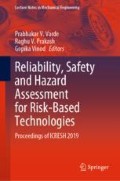Abstract
Nuclear power plant (NPP) is a highly complex engineering system which experiences a number of transients such as equipment failure, malfunctioning of process and safety systems, etc. during its operations. Such transients may eventually result in an abnormal state of the plant, which may have severe consequences if not mitigated. In case of such an undesired plant condition, the chances of the release of source term (e.g. release of Iodine, Caesium, Krypton, Xenon, etc.) and subsequent dose to public and to the environment cannot be neglected. The early knowledge of the expected release of source term will help in planning the emergency preparedness program. In view of this, several computational intelligence techniques have been studied and employed to early prediction of source term based on containment thermal-hydraulic parameters and also taking into account the actuation/non-actuation state of associated engineered safety features (ESFs). This paper presents an integrated framework based on artificial neural networks (ANNs) for early prediction of the expected release of source term during the large break loss of coolant accident (LOCA) in 220 MWe pressurised heavy water reactors (PHWRs). A simulated data of fission product release up to 48 h from the beginning of the LOCA has been considered in the model development. Several neural networks with forward and reverse configuration of the hidden layer were tried to reach at an optimal network for this problem. As the range of the input data was significantly large, a data transformation to a logarithmic scale was also performed to improve the efficiency and accuracy in prediction. The developed ANN model has been validated with the blind case LOCA scenarios. The performance of the final model is found to be satisfactory with a percentage error between actual and predicted value being under 5% expect for a few cases for all the species.
Access this chapter
Tax calculation will be finalised at checkout
Purchases are for personal use only
References
T.V. Santosh, A. Shrivastava, V.V.S. SanyasiRao, A.K. Ghosh, H.S. Kushwaha, Diagnostic system for identification of accident scenarios in nuclear power plants using artificial neural networks. Reliab. Eng. Syst. Saf. 54, 759–762 (2009)
Francesco Di Dedda, Definition of a dynamic source term module within RASTEP (Chalmers University of Technology, Sweden, 2013)
Samuel Glassstone, Alexander Sesonske, Nuclear Reactor Engineering (CBS Publications, New Delhi, 1998)
IAEA, Techniques and decision making in the assessment of off-site consequences of an accident in a nuclear facility, Safety series—88, Vienna (1987)
IAEA, Manual for First responder to a Radiological Emergency, Vienna (2006)
M. Knochenhauer, V.H. Swaling, F. Di Dedda, F. Hansson, S. Sjökvist, K. Sunnegård, Using Bayesian Belief Network (BBN) modelling for rapid source term prediction. Nordic Nuclear Safety Research, Sweden (2013)
M. Hage, H. Löffler, A probabilistic approach for source term prediction in case of severe accidents, in PSAM 13, Seoul, Korea (2016)
B. Yan, Y. Cui, L. Zhang, C. Zhang, Y. Yang, Z. Bao, G. Ning, Beam structure damage identification based on bp neural network and support vector machine. Hindawi Publishing Corporation-Mathematical Problems in Engineering (2014)
A.K. Jain, J. Mao, K.M. Mohiuddin, Artificial neural networks: A Tutorial. IEEE (1996)
S. Haykin, Neural Networks: A Comprehensive Foundation (MacMillan College Publishing Co., New York, 1994)
BIKAS, Neural Networks Simulator, Version 7.0.5, BARC (2005)
Author information
Authors and Affiliations
Corresponding author
Editor information
Editors and Affiliations
Rights and permissions
Copyright information
© 2020 Springer Nature Singapore Pte Ltd.
About this paper
Cite this paper
Santhosh, T.V., Mohan, A., Vinod, G., Thangamani, I., Chattopadhyay, J. (2020). Source-Term Prediction During Loss of Coolant Accident in NPP Using Artificial Neural Networks. In: Varde, P., Prakash, R., Vinod, G. (eds) Reliability, Safety and Hazard Assessment for Risk-Based Technologies. Lecture Notes in Mechanical Engineering. Springer, Singapore. https://doi.org/10.1007/978-981-13-9008-1_8
Download citation
DOI: https://doi.org/10.1007/978-981-13-9008-1_8
Published:
Publisher Name: Springer, Singapore
Print ISBN: 978-981-13-9007-4
Online ISBN: 978-981-13-9008-1
eBook Packages: EngineeringEngineering (R0)

